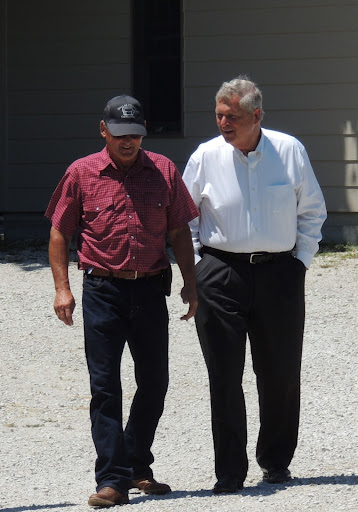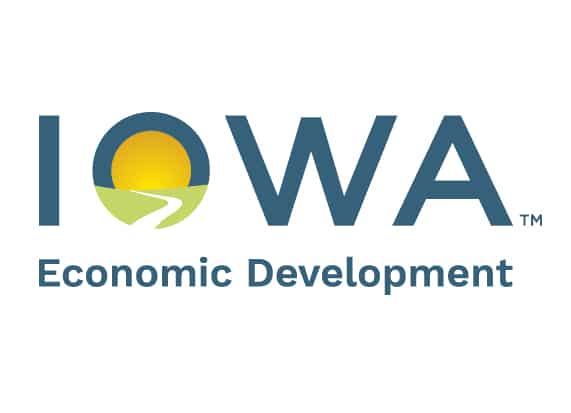Vilsack urges farmers to seek funds to offset derecho losses, warns of worsening, more expensive storms

MICHAEL CRUMB Jun 30, 2022 | 1:56 pm
5 min read time
1,237 wordsAll Latest News, Business Record Insider, EnergyMINBURN – Farmers who suffered market losses as a result of the August 2020 derecho that damaged millions of acres of crops and destroyed grain bins and other buildings can apply for funds through the $10 billion Emergency Relief Program, created to help farmers affected by natural disasters, U.S. Agriculture secretary Tom Vilsack said Wednesday.
Vilsack, who served as Iowa governor from 1999 to 2007, also warned that climate challenges facing U.S. farmers will only worsen, and he called for more flexibility in disaster programs to help them.
“We’re going to see stronger storms, more extensive damage and more expensive storms, and as we begin the process of thinking about the next [farm bill] we need to think about the flexibility in our disaster programs that will allow us to meet the demand and meet the circumstances of the situation,” he said.
 Vilsack spoke during a visit to the Nelson family farm about 33 miles northwest of Des Moines near Minburn in Dallas County. Owner Chris Nelson said his cornfields were flattened in the Aug. 10, 2020, derecho, and the metal grain bins at the nearby Heartland Cooperative were destroyed.
Vilsack spoke during a visit to the Nelson family farm about 33 miles northwest of Des Moines near Minburn in Dallas County. Owner Chris Nelson said his cornfields were flattened in the Aug. 10, 2020, derecho, and the metal grain bins at the nearby Heartland Cooperative were destroyed.The stop came a day after Vilsack visited Ely, Iowa, near Cedar Rapids, where he announced a $10 million initiative to fund innovation that would turn ag waste byproducts into other products for consumers.
On Wednesday, Vilsack, who was joined by U.S. Rep. Cindy Axne, said thousands of farmers like Nelson and his family can benefit from the Emergency Relief Program, which was set into law in 2021 and covers losses suffered in 2020 and 2021.
He said more than 120,000 farmers nationwide have received $4 billion since the application system began on May 16. Of that, $270 million has gone to about 12,500 Iowa farm families, Vilsack said as he spoke under shade trees in 90-degree temperatures with farm fields and a John Deere tractor as a backdrop.
The former Iowa governor said the purpose for his visit was to ensure that farmers sign up for the program.
The deadline to submit an application for assistance is July 22, Vilsack said.
The program offsets losses not covered by crop insurance, but for those who didn’t have crop insurance or had minimal losses, help is coming, too, he said.
“We’re going to have a second sign-up period later this summer for … approximately 9,000 farmers nationwide who had covered losses in 2020 and 2021, and about 10,000 producers who didn’t have coverage at all but had some limited amount of damage. They too will be eligible under this portion of the Emergency Relief Program,” Vilsack said.
Another $750 million has been set aside for producers who lost livestock, he said.
After the event, Vilsack sat down with the Business Record for a conversation about a variety of issues, ranging from help for farmers facing economic uncertainty to food insecurity and the baby formula shortage.
What can the government do to help farmers facing debilitating increases in input costs?
We’re making sure we’re creating less congestion at the ports. The USDA, for example, has created pop-up ports in Tacoma, Seattle, Oakland, Houston and Savannah, where containers are moved off docks so there is room for new shipments to come in. We’re working with the rail companies, saying, “Hey, guys, you need to pick up the pace.” Another issue is Ukraine. When we talk about global food shortages and about input costs, you have to put the blame where the blame belongs, and that’s Russia. It is absolutely the result of Russia’s interference. They are destroying crops in Ukraine. They are destroying storage facilities in Ukraine. They are destroying the transportation system in Ukraine and they are blocking the port so things can’t get out of the country. We can’t tell Russia to be reasonable, but what we can do is figure out ways to be less dependent on places like Russia. That’s why we initially announced a $250 million initiative to spur innovation in this area of fertilizer. The president told me to double it, so it’s now $500 million. Applications are going to be received by July 15 and we expect to see a broad range of strategies.
Talks are underway on a new farm bill. Is there an opportunity there to increase funding for food assistance programs?
We looked at the Thrifty Food Plan, which is the foundation of the SNAP program, the way in which you calculate what the traditional SNAP benefit should be. It’s taking a look at what an average family with an income who watches every penny, what do they buy at the store? How active are they? What is the price of food and what are we expecting from a dietary guidelines perspective? We took those four factors and put them into a set of calculations and it said to us that we have to increase the overall SNAP benefit by about $1.19 per day per person. That’s going to make a big difference. We can also make sure everyone who qualifies for SNAP receives SNAP. I was really struck that in some states that only 30% of senior citizens who are eligible for SNAP receive SNAP. That means 70% of seniors who are eligible for SNAP are still living on that fixed income and trying to choose between prescription drugs, rent and what they eat. In addition to looking at the cost of the program we’re looking at ways we can expand those who are eligible to receive the benefit. Another is [the Women, Infants and Children program]. Fifty percent of WIC beneficiaries who qualify don’t get benefits, so we’re doing an in-depth dive to figure out how we increase participation in those programs. Finally there is the school meal program. We’ve asked Congress to continue the waiver that would allow the universal free meals for another school year. Congress made the decision not to do that, but they recently passed some degree of assistance, which together with what we can do at USDA is going to make it a little easier for nutrition folks at schools to provide a decent meal.
What’s the latest on efforts to restock shelves with baby formula?
The good news is we’re bringing in formula from all over the world. That continues. We had a bit of a setback when the [Abbott Nutrition] Sturgis [Michigan] plant was flooded, but that’s going to get back online relatively soon, and … another facility is being constructed [in another state]. So I think over time, we’re going to see, slowly, the stabilization. What’s interesting is if you look at the percentage increase in purchasing, you would think that with the shortage there is less being purchased today than before the pandemic. Actually it’s 24% higher. So that tells me there’s product, but it’s going off the shelf quickly. Now why is it going off the shelf quickly? Maybe people are thinking if one can is good, maybe two cans is even better. So I think we have to get through that period to where people feel more confident, more comfortable with normal purchasing. We’re getting there. When the Sturgis plant comes back online, it will be a big help.
Photo above: U.S. Agriculture Secretary Tom Vilsack, right, speaks with Chris Nelson on Wednesday at Nelson’s farm near Minburn where Vilsack talked about Emergency Relief Program funds available to help farmers who suffered losses from natural disasters. Photo by Michael Crumb










